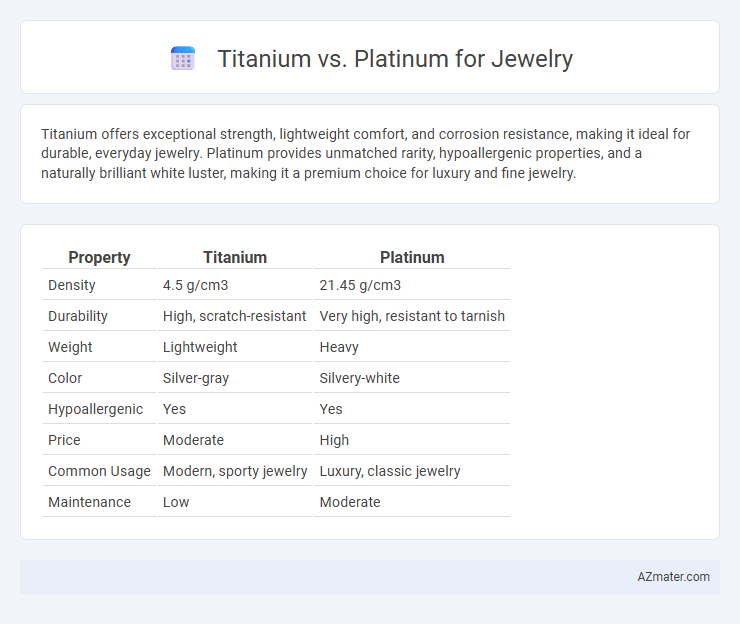Titanium offers exceptional strength, lightweight comfort, and corrosion resistance, making it ideal for durable, everyday jewelry. Platinum provides unmatched rarity, hypoallergenic properties, and a naturally brilliant white luster, making it a premium choice for luxury and fine jewelry.
Table of Comparison
| Property | Titanium | Platinum |
|---|---|---|
| Density | 4.5 g/cm3 | 21.45 g/cm3 |
| Durability | High, scratch-resistant | Very high, resistant to tarnish |
| Weight | Lightweight | Heavy |
| Color | Silver-gray | Silvery-white |
| Hypoallergenic | Yes | Yes |
| Price | Moderate | High |
| Common Usage | Modern, sporty jewelry | Luxury, classic jewelry |
| Maintenance | Low | Moderate |
Introduction: Titanium vs Platinum for Jewelry
Titanium and platinum are popular choices for jewelry due to their durability and distinctive appearances. Titanium offers exceptional strength, lightweight comfort, and resistance to corrosion, making it ideal for everyday wear. Platinum, renowned for its rarity and natural white luster, provides timeless elegance and hypoallergenic properties favored in luxury jewelry.
Physical Properties Comparison
Titanium jewelry offers superior strength and exceptional corrosion resistance compared to platinum, making it highly durable and lightweight for everyday wear. Platinum, known for its dense and heavy nature, provides a luxurious feel and excellent tarnish resistance but is softer and more prone to scratches than titanium. The distinct differences in density--titanium at approximately 4.5 g/cm3 versus platinum at 21.45 g/cm3--significantly impact comfort and longevity in wearable jewelry pieces.
Durability and Strength
Titanium offers exceptional durability with a tensile strength of around 434 MPa, making it highly resistant to scratches, bending, and corrosion, ideal for everyday jewelry wear. Platinum, while softer with a Mohs hardness of 4-4.5, boasts superior density and malleability, providing durability through its ability to withstand impacts without cracking. Both metals excel in strength; titanium is lightweight and resilient, whereas platinum ensures longevity with its heavy, robust composition.
Hypoallergenic Qualities
Titanium is highly valued in jewelry for its excellent hypoallergenic properties, making it ideal for individuals with sensitive skin or metal allergies. Unlike platinum, which can sometimes contain trace amounts of nickel or other allergens due to alloying, pure titanium is naturally resistant to corrosion and unlikely to cause any skin irritation. This makes titanium a preferred choice for hypoallergenic jewelry without compromising durability or style.
Weight and Comfort
Titanium jewelry is significantly lighter than platinum, offering enhanced comfort for everyday wear due to its low density of approximately 4.5 g/cm3 compared to platinum's 21.45 g/cm3. The lightweight nature of titanium reduces finger fatigue and makes it an excellent choice for those seeking durable yet comfortable pieces. Platinum's heavier weight lends a luxurious, substantial feel but may be less comfortable for extended wear, especially in larger or bulkier designs.
Color and Aesthetic Appeal
Titanium jewelry features a sleek, modern grayish-silver hue that retains its color without tarnishing, ideal for those seeking a durable, contemporary look. Platinum offers a naturally bright white sheen with a subtle luster that enhances gemstones, prized for its timeless elegance and classic appeal. Both metals provide distinct aesthetic qualities, with titanium delivering a more industrial style and platinum exuding luxurious sophistication.
Maintenance and Care Requirements
Titanium jewelry requires minimal maintenance due to its high resistance to scratches, tarnish, and corrosion, making it ideal for everyday wear without frequent polishing. Platinum, while highly durable and hypoallergenic, develops a natural patina over time and benefits from periodic professional polishing to maintain its lustrous finish. Both metals require gentle cleaning with mild soap and water, but platinum's softer nature demands more careful handling to avoid surface damage.
Pricing and Value
Titanium jewelry is significantly more affordable than platinum, with prices often ranging from 10% to 30% of platinum's cost per gram, making it an excellent choice for budget-conscious buyers. While platinum boasts exceptional durability and a prestigious status, titanium offers superior strength-to-weight ratio, corrosion resistance, and hypoallergenic properties, enhancing its overall value for everyday wear. The long-term value of platinum is supported by its rarity and resale potential, whereas titanium's lightweight comfort and low maintenance make it a practical investment for modern jewelry enthusiasts.
Popular Jewelry Applications
Titanium is prized for its lightweight, hypoallergenic properties, making it ideal for everyday rings, bracelets, and watches, especially in men's and sports jewelry. Platinum, valued for its dense, durable, and naturally white luster, is predominantly used in high-end engagement rings and luxury wedding bands. Both metals offer corrosion resistance, but titanium's affordability and modern appeal contrast with platinum's traditional prestige and heavier feel in popular jewelry applications.
Choosing the Best Metal for Your Jewelry
Choosing between titanium and platinum for jewelry depends on factors like durability, weight, hypoallergenic properties, and budget. Titanium offers exceptional strength, lightweight comfort, and corrosion resistance, making it ideal for everyday wear and active lifestyles. Platinum, valued for its rarity, natural white sheen, and longevity, provides a prestigious, heavier option that develops a unique patina over time, appealing to those seeking luxury and timeless elegance.

Infographic: Titanium vs Platinum for Jewelry
 azmater.com
azmater.com